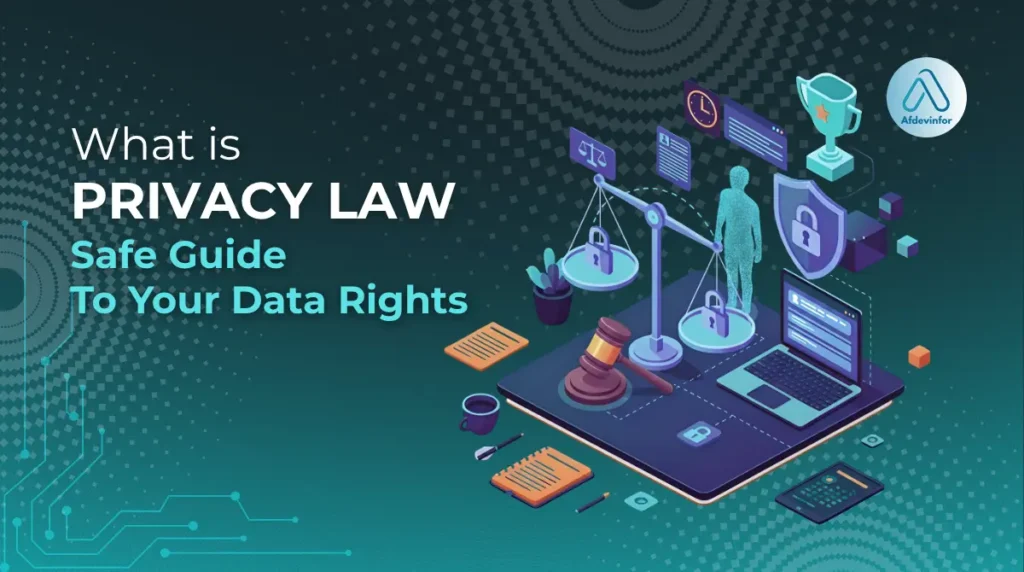Have you ever clicked ‘Accept All Cookies’ without a second thought? That single click connects you to a global web of rules, and understanding what is privacy law is the first step to navigating it safely. In my decade of experience in digital security, I’ve seen how these laws are not just for lawyers; they are the fundamental digital rights that protect you every day.
This guide is my attempt to demystify these rules, giving you a practical understanding of your rights and risks in the online world. At its core, privacy law is about establishing your personal information rights, defining how your data can be collected, used, and shared, and giving you control over your digital identity through concepts like data protection and digital consent.
Privacy law is a legal framework that governs how an individual’s personal information is gathered, stored, and used. Its primary goal is to protect a person’s right to be left alone and to control how their personal details are handled by organizations.
1.1. The real-world importance of privacy law in the digital age
It’s easy to think of these laws as abstract concepts, but they have a massive impact on your daily life. From the moment you check your social media in the morning to the online shopping you do at night, privacy laws are working in the background to prevent the misuse of your data, protect your identity, and help you maintain personal autonomy.
Here’s how their importance breaks down in tangible terms:
- For Individuals: Think about the data your fitness app collects on your health and location. Privacy law is the barrier that ensures this sensitive information can’t be sold to an insurance company to raise your premiums without your explicit consent. It gives you the right to see what a company knows about you and to demand its deletion.
- For Businesses: For companies, respecting these laws isn’t just about avoiding fines; it’s the foundation of customer trust. Proper privacy and data security practices show customers that a business values them beyond a simple transaction, building loyalty and a positive reputation in a world where data breaches are common.
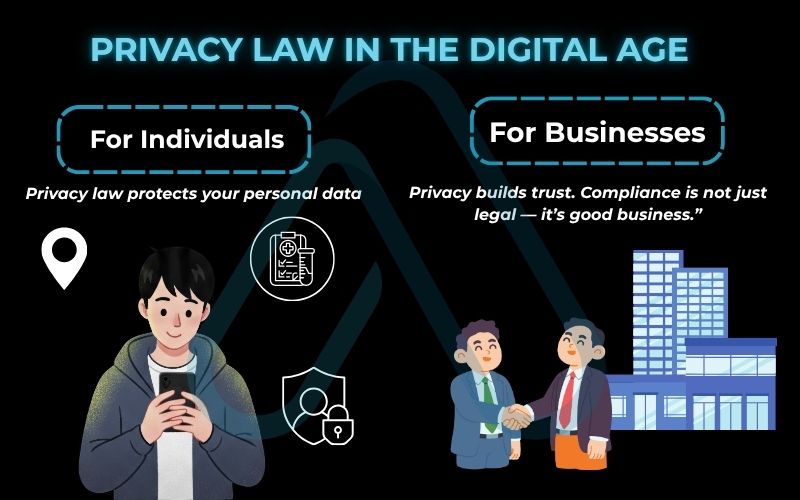
1.2. The difference between data protection and privacy law
Many people use these terms interchangeably, but they represent two sides of the same coin. I find a simple analogy helps clear up the confusion: Data Privacy is the ‘what’ and ‘why’, while Data Protection is the ‘how’. Privacy law sets the rules for what data can be collected and why, establishing your rights. Data protection regulations are the technical and organizational measures used to actually secure that data and enforce those rights.
This table offers a clearer comparison:
| Data Privacy | Data Protection |
|---|---|
| Scope: Defines the legal rights of individuals regarding their personal information. | Scope: Focuses on the mechanisms and security measures to prevent unauthorized access to data. |
| Focus: The principles and rules for collecting, processing, and sharing data legally and ethically. | Focus: The implementation of safeguards like encryption, access controls, and secure networks. |
| Goal: To empower individuals with control over their personal data. | Goal: To secure data against internal and external threats and breaches. |
2. The core principles that power modern privacy laws
Across the globe, most modern privacy laws are built on a set of foundational ideas. Understanding these privacy law principles helps you recognize what good (and bad) data handling looks like. From my experience, these are the core tenets that appear in nearly every major regulation.
Here are the key principles broken down:
| Principle | Description | Real-world example |
| Data Minimization | This principle dictates that organizations should only collect the data that is absolutely necessary for a specific purpose. | A newsletter sign-up form should only ask for your email address, not your home address or phone number, as that extra information isn’t needed to send you an email. |
| Purpose Limitation | Data collected for one reason cannot be used for another, unrelated reason without your consent. | A retail website collects your address to ship you a product. They cannot then sell that address to marketing companies without asking you first. |
| Consent | Your permission must be freely given, specific, informed, and unambiguous before a company can process your personal data. | A checkbox that is already ticked is not valid consent. You must actively tick the box yourself to opt-in. |
| Security | Organizations are required to implement appropriate technical and organizational measures to protect the personal data they hold. | This includes using encryption to protect customer databases and training employees on how to handle sensitive information securely. |
| Individual Rights | You have fundamental rights over your data, including the right to access it, correct inaccuracies, and in many cases, request its deletion (the ‘Right to be Forgotten’). | You can contact a social media platform and request a copy of all the data they have stored about you. |
3. How much do you really know about what is privacy law in practice? A risk assessment
It’s time for a personal privacy health check. Answering some simple questions can reveal how exposed your data might be. As a thought exercise for a graphic designer, here’s the logic for a simple risk flowchart:
Start with a question like, 'Do you use public Wi-Fi?'.
- If the user answers ‘Yes’, the next question is ‘Do you use a VPN?’.
- If the answer is ‘No’, they land on a ‘HIGH RISK’ outcome with a suggestion to get a VPN.
- If ‘Yes’, they might move to another question about app permissions.
This interactive approach helps you take the first steps toward your own digital privacy compliance by identifying your biggest vulnerabilities and taking immediate action.
3.1. Checklist for individuals: A 5-step personal data audit
Taking control of your data starts with knowing where it is. I recommend performing this simple audit every six months. It’s an empowering process that puts theory into action.
Here is my go-to checklist for a personal data audit:
- Audit Your App Permissions: Go to your phone’s settings (Privacy & Security) and review which apps have access to your camera, microphone, location, and contacts. If an app doesn’t need access for its core function (e.g., a simple game wanting your contacts), revoke that permission immediately.
- Review Social Media Privacy Settings: Platforms frequently update their settings. Check who can see your posts, who can tag you, and how your data is used for advertising. Limit public visibility on everything except what you explicitly want to share widely.
- Manage Your Cookies and Browser History: Regularly clear your browser cookies and history. Use a privacy-focused browser or install extensions that block third-party trackers to limit how you are followed across the web.
- Check Data Breach Monitoring Services: Use a free service like ‘Have I Been Pwned’ to see if your email address has been compromised in any known data breaches. If it has, change your password for that service immediately.
- Exercise Your Personal Information Rights: Pick one service you use frequently and practice your rights. Contact their support and ask for a copy of your data. The process itself will teach you a lot about how companies handle these requests.
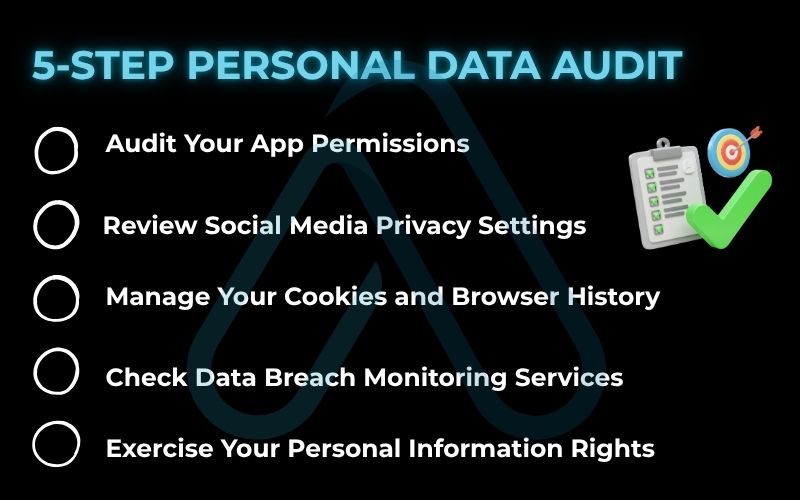
3.2. Getting started with privacy compliance for small businesses
If you run a small business, privacy law might seem daunting, but it doesn’t have to be. Building trust with customers starts with respecting their data. Focusing on a few foundational steps is far more effective than trying to do everything at once.
Here’s a simple framework to get started with digital privacy compliance:
- Map Your Data: Before you can protect data, you need to know what you have. Create a simple document that lists what personal data you collect (e.g., names, emails, addresses), where you store it (e.g., CRM, email list), and why you need it. This is the single most important first step.
- Create a Simple Privacy Policy: Your privacy policy doesn’t need to be filled with legal jargon. It needs to clearly and honestly tell users what data you collect, why you collect it, how you protect it, and how they can contact you to exercise their rights.
- Understand Consent: Review how you get permission to collect data. For your marketing email list, for example, ensure you are using an ‘opt-in’ method where users actively agree to be added, rather than an ‘opt-out’ method with a pre-checked box.
- Secure Your Data: Implement basic security measures. This includes using strong, unique passwords for all your business accounts, enabling two-factor authentication, and ensuring any software you use is kept up to date to protect against vulnerabilities. This is a core part of all data protection regulations.
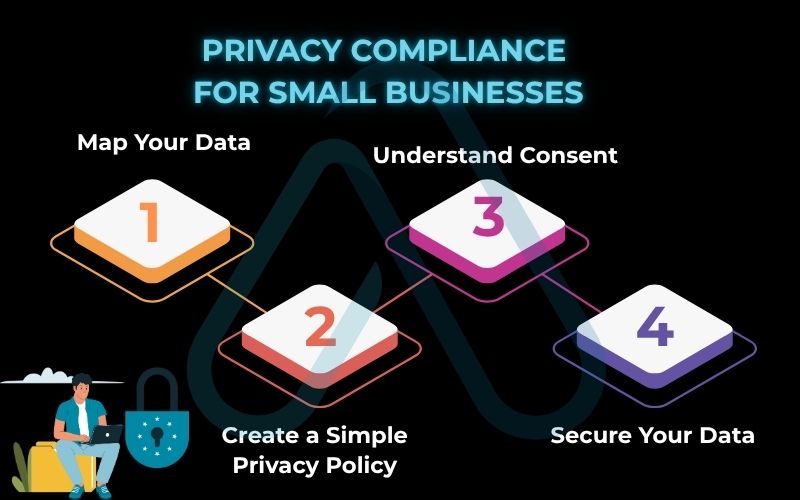
4. A tour of major global privacy laws
While the core principles are similar, privacy laws vary across the globe. Understanding the major players helps you understand why websites present you with different pop-ups and options depending on your location. This isn’t an exhaustive legal review, but a practical look at the global privacy laws that shape our digital world.
Here is a quick tour of the most influential regulations:
| Law / Regulation | Region | Key feature | Who it affects |
| GDPR (General Data Protection Regulation) | European Union (EU) | I consider this the gold standard. It grants a wide range of individual rights, including the famous ‘Right to be Forgotten’. It requires explicit, opt-in consent for data collection. | Any organization anywhere in the world that processes the personal data of people inside the EU. |
| CCPA/CPRA (California Consumer Privacy Act / California Privacy Rights Act) | California, USA | Grants consumers the ‘Right to Opt-Out’ of having their personal information sold or shared. It was a landmark privacy law in the United States. | Larger businesses that operate in California and meet certain revenue or data processing thresholds. |
| LGPD (Lei Geral de Proteção de Dados) | Brazil | Heavily inspired by the GDPR, the LGPD creates a comprehensive legal framework for data protection in Brazil, establishing individual rights and business obligations. | Any person or organization, public or private, that processes the data of individuals in Brazil. |
| PIPEDA (Personal Information Protection and Electronic Documents Act) | Canada | A federal law that governs how private-sector organizations collect, use, and disclose personal information in the course of commercial activities. | Most private businesses operating in Canada. |
4.1. Who has the strictest privacy laws when comparing countries?
This is a common question, and the answer generally points to the European Union’s GDPR. The key difference lies in the philosophical approach. The EU treats privacy as a fundamental human right, leading to a rights-based model. The U.S., by contrast, has historically used a sectoral approach, with specific laws for specific industries (like healthcare or finance) rather than one overarching regulation.
This is why you see different cookie banners; in Europe, consent must be an explicit action (opt-in), while in some parts of the U.S., it can be implied until you opt-out. Here is a simplified comparison of these different approaches to global privacy laws:
| Criteria | EU (GDPR) | USA (CCPA/CPRA) | Brazil (LGPD) | Canada (PIPEDA) |
|---|---|---|---|---|
| Consent Model | Opt-in (explicit) | Opt-out (for sale of data) | Opt-in (explicit) | Implied or explicit, depending on context |
| Key Data Subject Rights | Access, Rectification, Erasure, Portability | Know, Delete, Opt-Out of Sale/Sharing | Access, Rectification, Deletion, Portability | Access and Correction |
| Potential Fines | Up to 4% of global annual revenue or €20 million | Up to $7,500 per intentional violation | Up to 2% of revenue in Brazil, capped at R$50 million | Up to CAD $100,000 per violation |
As this table shows, the scope of rights and the severity of penalties under data protection regulations can vary significantly by region.
5. Privacy law in action
To truly understand what is privacy law, you need to see its impact. Theory is one thing, but seeing the consequences of compliance or non-compliance makes the rules feel real. I’ve followed many cases over the years, and a few stand out as powerful lessons.
| Case study | Situation | Violation | Outcome |
| Case Study 1: The GDPR Fine | A major social media company was found to be using ‘dark patterns’ in its interface, making it confusing and difficult for users to refuse consent for data processing. | The company violated the GDPR’s core principle of freely given and unambiguous consent. | The Irish Data Protection Commission levied a fine of several hundred million euros. This case showed that not just data breaches, but also deceptive design, carries significant privacy breach consequences. |
| Case Study 2: The Data Breach | A large hotel chain suffered a massive data breach, exposing the personal and financial details of millions of customers, including passport numbers and credit card information. | The company failed to implement adequate security measures to protect user data, a key requirement under most privacy laws. | Beyond a significant fine from regulators, the company faced class-action lawsuits and immense reputational damage, demonstrating the high cost of failing at digital privacy compliance. |
| Case Study 3: The Positive Example | A tech company known for its privacy-focused products built its business model around data minimization from the ground up. | None. | The company uses its strong privacy stance as a key market differentiator. It has built a loyal customer base that trusts the brand, proving that good privacy practices can be a competitive advantage, not just a legal burden. |
6. What’s next on the horizon for the future of privacy?
The world of privacy law is constantly evolving to keep pace with technology. As an expert in this field, I’m always watching for the next big challenge to our digital rights. The laws we have today are just the beginning of a long conversation about how we want to live in a data-driven world.
Here are a few key trends I believe will shape the future of privacy and data security:
- Artificial Intelligence (AI): How will AI models be trained ethically? The massive datasets used to build AI systems raise huge questions about consent and purpose limitation. Future laws will need to address how our data is used to create these powerful technologies.
- Biometrics: The use of fingerprints, facial recognition, and other biometric data is becoming more common. This is some of the most sensitive personal information we have, and regulations will need to become much stricter about how it is collected, stored, and used.
- Internet of Things (IoT): Every smart device in our homes, from speakers to refrigerators, is a data collection point. Securing this vast network of devices and ensuring the data they gather is handled responsibly is one of the biggest challenges we face.
- Cross-Border Data Flows: As data moves seamlessly around the globe, creating international agreements and standards for protecting it will be a major focus for governments and regulators in the coming years.
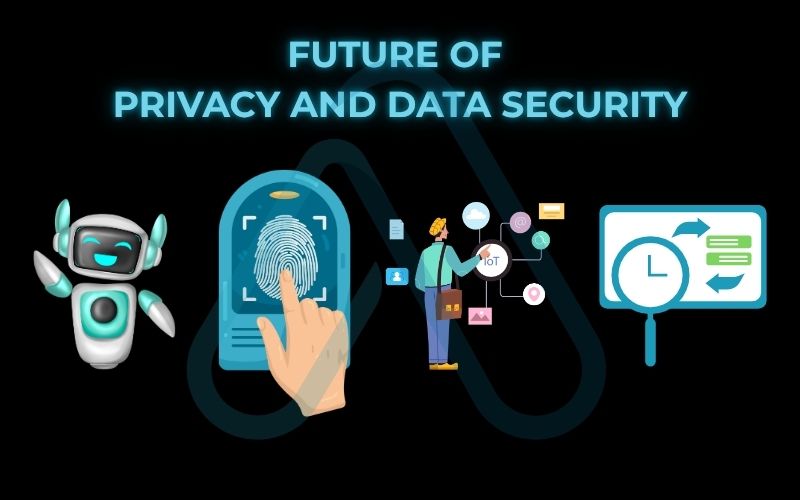
7. FAQs about what is privacy law?
Here are some quick, clear answers to the most common questions I get about privacy law.
How does privacy law affect people and businesses?
- For individuals: you get rights over your personal data (access, correction, deletion in many regions).
- For businesses: they must be transparent, keep data secure, and provide ways for users to use those rights.
What are the consequences of a privacy breach?
- For businesses: big fines, legal costs, reputation damage, loss of trust.
- For individuals: identity theft, financial loss, harassment, personal stress.
Can I ask a company to delete my data?
Yes. Under laws like GDPR, you can request deletion unless the company has a legal reason to keep it.
Do all websites need a privacy policy?
If they collect personal data, yes in practice. Major regulations require it and it’s a basic trust-building step.
Glossary of key terms
| Abbreviation | Full Term | Meaning |
|---|---|---|
| GDPR | General Data Protection Regulation | The landmark data privacy and security law enacted by the European Union. |
| CCPA/CPRA | California Consumer Privacy Act / California Privacy Rights Act | A set of state-wide data privacy laws that grants consumers rights over their personal information in California. |
| LGPD | Lei Geral de Proteção de Dados | Brazil’s comprehensive data protection law, heavily inspired by the GDPR. |
| PIPEDA | Personal Information Protection and Electronic Documents Act | Canada’s federal privacy law for private-sector organizations. |
| PII | Personally Identifiable Information | Any data that can be used to identify a specific individual, such as name, address, or social security number. |
| VPN | Virtual Private Network | A tool that creates a secure, encrypted connection over a public network like the internet. |
| IoT | Internet of Things | A network of physical devices embedded with sensors and software that connect and exchange data over the internet. |
| AI | Artificial Intelligence | The simulation of human intelligence in machines, programmed to think and learn. |
8. Final thoughts
Navigating the digital world requires being informed. After years of working in this space, I’ve come to see that privacy law isn’t a barrier; it’s an enabler. It’s the framework that allows us to innovate and connect online with a baseline of trust and safety. Understanding what is privacy law is the first and most critical step you can take to reclaim control over your digital footprint and protect yourself from risks.
Here are the most critical takeaways I want you to remember from this guide:
- Privacy law provides you with fundamental rights over your personal information, including the right to access, correct, and delete it.
- The core principles of data minimization, purpose limitation, and consent are the bedrock of modern, trustworthy data handling practices.
- For businesses, digital privacy compliance is not just a legal obligation but a cornerstone of building and maintaining customer trust.
- You can take immediate, practical steps like auditing app permissions and managing cookies to improve your personal data security today.
Feeling empowered with this knowledge is a great start. The next step is to continue learning and applying these principles. For more in-depth guides, explore our Online Security & Privacy categories on Afdevinfo.


